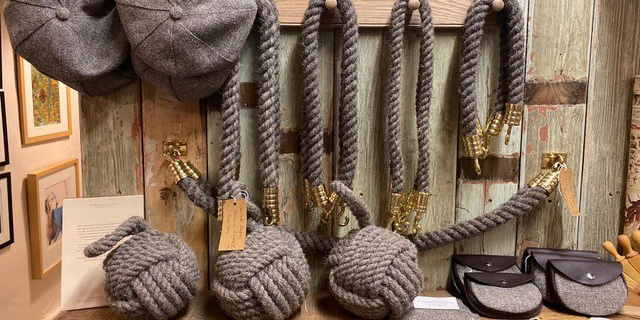
23 March 2023
The wool industry and its impact on the Lake District stretches back many hundreds of years. Back to when Crown and Church owned the land, managed the land and stock through tenant farmers, and produced vast quantities of wool for the nation. Traditional Lakeland sheep farming shaped the beloved landscape seen today and is the bedrock of the Lake District’s World Heritage story. It is only in the last few decades has the choice of clothing materials broadened and the mass market demand for wool declined. Even only recently the price of fleeces was so low that many sheep farmers had to destroy theirs. It is against this backdrop that makes what is happening at Finsthwaite Farm particularly special.
The farm is still a traditional upland sheep farm, rearing Herdwicks and Charollais for meat, to be sold via local auction marts. The number of sheep is reducing year on year, and cattle numbers growing, as the farm strives for a less intensive system that can be managed in a way that is beneficial to the diverse environment.

However, there’s still the question of what to do with the fleeces. Farmer Charlotte Chaplin has found the answer. Make high quality tweed from her Herdwick wool, that can be used to make the finest garments and interiors.
Herdwicks are born black, and change colour as they mature, from chocolate through to grey and even white, Charlotte is able to clip her sheep at different age stages, and collect wool in three tones; rich chocolate brown, mid and pale grey. From these three colours, Charlotte creates a variety of colour patterned, undyed and sustainable tweed. The business has grown to the point where Charlotte has to source more Herdwick fleeces from a couple of upland farms in the Duddon valley.

To get from wool to tweed is a long process. Back when wool cloth was still in high demand, fleeces would leave the farms for the mills, where they would be washed by being paddled in vast vats, carded (combing the wool until the fibres would be aligned), have the short yet irritating itchy fibres removed, spun and woven, all in the one place. Sadly this vertical industry no longer exists. Instead Charlotte works with some of the country’s last remaining spinners, weavers and wool finishers, across Lancashire and Yorkshire. The end product is a beautiful, practical and iconic material, that can be used for clothing, curtains and upholstery, a material that is warm, hypoallergenic, breathable, entirely natural and sustainable.
Charlotte’s tweed is already being used by well-known countryside outfitters, and is also available to buy direct from the farm as 150cm wide rolls, up to 35m in length. Simply visit www.charlottechaplin.co.uk for inspiration and place your order for tweed or any of her products!